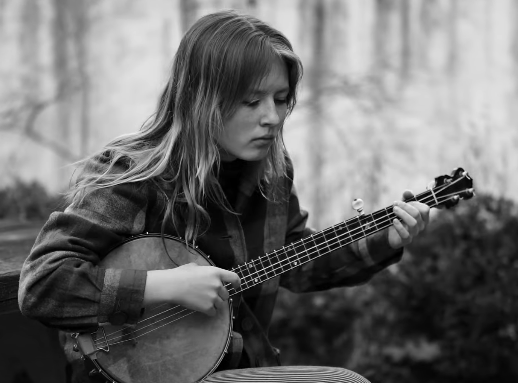The banjo prodigy Nora Brown is now sixteen and the prefix “Little” has been dropped from her stage name. Raised in Brooklyn, her musical education began at six with the ukulele. Her first teacher was Shlomo Pestcoe, a jovial man with rivers of white hair, one of a long line of Jewish New Yorkers who has done much to preserve and popularize Appalachian music. Amid the clutter of instruments and stacks of CDs in Pestcoe’s apartment Brown learned her first old-time songs. Her acquaintance with the banjo started around the age of ten, and soon she was making trips to the southeast US to study with aging masters like Lee Sexton and George Gibson. A YouTube video shows Brown at age twelve sitting on a sagging couch with a ninety-year old Sexton in overalls as he teaches her “Cumberland Gap” in the beautiful two-finger style. It has been Brown’s dubious honor to be unofficially laureled as old-time’s best hope for survival, granted appearances on the TED channel and NPR’s tastemaking Tiny Desk Concert series. This early prestige has invited listeners to hear Brown’s music as the work of a savant, when it is more simply the work of an accomplished musician. Her first album, released at age thirteen, already bears the trademarks of a distinctive style: gossamer fingerwork, melodic phrases that give way to sudden pauses and silences, frequent use of softer nylon strings instead of the twangier standard steel kind, a special facility with slow tunes; vocally, a recessive quality, her words intoned almost reluctantly.
This disposition of inwardness sets her apart from the conviviality of many of her forebears. A legend of old-time music like Tommy Jarrell hollered while strumming the banjo, the singer and his instrument sounding like close friends engaged in riotous conversation. The difference may partly reflect changes in recording technology. Many of the canonical recordings of old-time musicians from the last century feature men and women performing on front porches, in living rooms, and in other informal social settings, unaccompanied by microphones, or else projecting loud enough to make amplification unimportant. Loudness also allowed the banjo to be heard over the tromp of dancers’ feet. The evolution of the microphone in the mid-century opened up myriad possibilities for singing and playing. Around this time in Brazil, for example, João Gilberto discovered the sound of bossa nova while singing in his sister’s tiled bathroom. To reproduce this acoustic quality in the studio, he began making albums in which his voice and guitar seemed to emanate a hair’s breadth from the listener’s ears, almost too close. Just a few notches above a whisper, Gilberto’s voice was curiously uninflected by feeling, but in spite, or maybe because of this, it was also supremely intimate. The writer Ben Ratliff describes the transformation that popular samba tunes underwent in Gilberto’s hands: “They were once social songs. Now they’re cloistered, but they still have the samba rhythm inside them: Gilberto could create it alone.”
I think you can hear a similar transformation of cherished old-time songs in Nora Brown’s playing. Garrulous tunes are resurrected as introspective reveries: they’ve left behind the din of the square dance for the privacy of the attic. Familiar lyrics that listeners are accustomed to hearing belted out rise from and subside into silence. Recorded in a cave thirty feet below street-level in Brooklyn, Brown’s new album Sidetrack my Engine does not have the studio-crafted meticulousness of Gilberto’s songs, but it shares in his confidentiality. An interesting example is the song Frankie and Albert. A blues ballad about a woman named Frankie who killed her unfaithful lover Albert in a well-publicized 1899 scandal, the song has passed through innumerable variations, including a marvelously lively rendition by Taj Mahal, who narrates the story’s drama with an old raconteur’s gusto. In Nora Brown’s rendering “Frankie and Albert” comes to us wreathed in the mists and shadows of memory. The dramatic force of the story has been evacuated; in place of narrative immediacy is a serene mood of elegy. “Frankie and Albert” is no longer an item of pressing news relayed through the town market but something else, perhaps the tale of a former friend recollected on an evening many years after the murder. From the banjo, which she plays in the two-finger style, Brown elicits ringing, jewel-like tones, without twang. Sitting near the front during her album release show, it seemed possible to me that the audience had meandered into Brown’s personal quarters and found her sitting there, playing for no one in particular.
Besides refining one of the singular styles in old-time music today, Sidetrack my Engine offers the pleasure of hearing two creative forces finding each other at the right time: Nora Brown and the talented multi-instrumentalist Jerron “Blind Boy” Paxton. Here Paxton plays the bones, a hand-held percussion instrument associated in the US with blues and minstrel shows in the early 20th century. Like any instrument that has not widely survived beyond a remote patch of time, the bones risk appearing as a quaint anachronism, trotted out to satisfy the curiosity of 78 collectors and the historically-minded. But what Paxton and Brown have created together is thrillingly new. In these duets the traditional timbral roles of stringed instrument and percussive instrument have been exchanged: Brown’s nylon-stringed banjo draws soft, resonantly bassy circles while Paxton’s bones crackle with nasal clarity high above, like Spanish castanets making merry graveyard chatter. Instead of thumping or chugging, the banjo arrives as a quicksilver flutter of notes ascending through the air. The fiddler Bruce Molsky has observed that what sets old-time Appalachian music apart from other forms of folk for him is its special concentration on the language of rhythm; and in their collaborations I hear Brown and Paxton replenishing this tradition’s great stores of rhythm, returning to the joys of nimbleness and fleetness. As Paul Valéry has it, “One must be light like the bird, not like the feather.”




